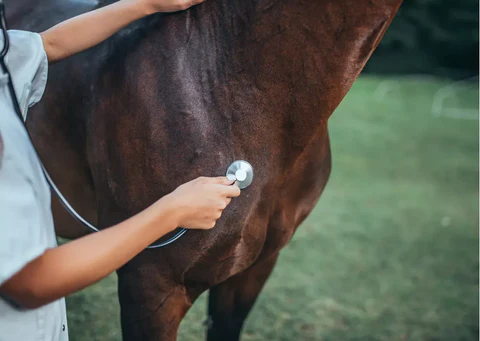As far as we are concerned, there is nothing cuter than a newborn foal. Little wonder so that you can’t wait to see one frolicking through the meadow. One problem: you can’t seem to get your mare in foal. Infertility is a complex and frustrating problem - for you, your vet, and your horse. Your mare’s inability to conceive can have several causes. For your convenience, we list the most important here.
1. The ovum isn’t fertilised
That can be due to the mare or the stallion.
The mare’s egg cell may be of poor quality, perhaps no egg cell was released during ovulation, or the timing of the insemination may have been off.
Mares have a seasonal cycle and are at their most fertile between May and September. This is when the chance of successful ovulation is the greatest. Incidentally, the older your mare, the poorer the quality of her egg cells.
Another possibility is that the quality of the stallion’s semen wasn’t good enough to fertilise the egg cell. Fresh semen tends to be better than chilled or frozen semen. Furthermore, the quality will very much vary from stallion to stallion.
2. The fertilised egg cell does not implant itself in the uterus
This is usually due to the health of your mare’s endometrium (or to give it its full title: the inner epithelial layer along with its mucous membrane). As it happens, the endometrium produces a type of milk that feeds the fertilised egg cell (1).
2.1. Disorders of the endometrium are an important cause of infertility in mares. The most common ones:
- Fibrosis (endometriosis)
- Damaged blood vessels
- Inflammation (endometritis)
- Breakdown of the endometrial glands
Did you know that 64 % of all clinically healthy mares have some degree of fibrosis (endometriosis) in the uterus? This condition reduces the chances of egg cell implantation. The older the mare, the more serious the fibrosis (2,3).
2.2. Also, inferior anatomy of the reproductive system can affect the health of the uterus.
English Thoroughbreds have a greater chance of air getting sucked into the uterus because of the unfortunate position of the vagina and vulva. Saddlebreds, on the other hand, tend to suffer from fungal infections, because of an abnormal cervix (4).
3. The embryo dies after implantation
If the embryo dies during the first two months of gestation, we speak of early embryonic death. This occurs in four to twenty percent of all mares.
If the embryo dies after more than forty days, we speak of abortion. This occurs in seven to eight per cent of embryos. The most common (infectious) cause of abortion is rhinopneumonitis, caused by the equine herpes virus (EHV-1 and 4). So, make sure to vaccinate your mare against this menace, prior to and during gestation.
If your mare seems unable to get in foal, it’s time to visit your vet so that he or she can examine your mare and establish the cause of the problem. There are also a number of things you can do to give your infertile mare a helping hand. Success and may you be welcoming your very own foal before long!



